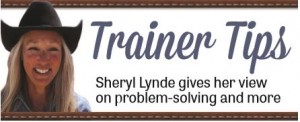 I had purchased a Paint gelding when he was four years old. At the time, I was living in Durango and I just wanted a good-minded gelding to ride in the mountains of Colorado.
I had purchased a Paint gelding when he was four years old. At the time, I was living in Durango and I just wanted a good-minded gelding to ride in the mountains of Colorado.
When I did ride him in an arena setting, I noticed getting him on his right lead was incredibly difficult. He was used in roping primarily, and when horses come out of the box, they are on their left lead in order to be in position on the cow. The more I tried, the more animated his refusals became. He showed his frustration first by crow-hopping, which eventually progressed into bucking.
Over time, his bucking began to be his “go to” behavior whenever he became fearful or aggravated. When riding up in the mountains, if he spooked, he’d follow it with a buck. If I ponied another horse and the lead rope touched his hindquarters, he would use that as a great excuse to buck as well.
Sometimes I landed on my feet, but not too often. He bucked with a purpose and didn’t stop until I was off his back. Even though I immediately climbed back in the saddle and put him to work, the buck was still present, living just below the surface of his seemingly calm demeanor.
Finally, I sought out a trainer. I spoke to someone in my area who instructed me to snub him up to a post with a rope tied under his tail and let him buck it out. His advice may have worked, but I didn’t see it as a training solution, just a possible train wreck. I eventually signed up for John Lyons certification program — I wanted to learn. I was all-in.
All in all, it’s just a six-month program. The first session was three weeks of ground work — very specific ground work. Not working the lungs, but working the mind. Eight hours a day. After that first session, Lil’ Joe never bucked again and that taught me the importance of ground work. If you can ride a buck, then good for you — you are a great rider. I can’t always ride it through, nor do I want to. If, instead, you teach the horse he doesn’t have to buck, then you won’t have to ride the buck.
That was almost 15 years ago. Lil’ Joe is 24 years old now, and he’s the best ranch horse I could’ve hoped for. I’ve taken what I learned at John’s as well as what I have learned with each horse I have worked over the years and developed my own program. I’ve given many demonstrations on him — he has helped me start colts and has brought confidence to many a fearful rider. Have I told the riders what a great bucker he was at one time? Nope.
Problems are a symptom of a cause. If you identify and resolve the cause, then the problem disappears. But people have a tendency for living in the negative experiences of their past. We become addicted to reliving adverse experiences because of the emotion attached to the incident. According to Dr. Joe Dispenza, most people wear their emotions layer by layer and they believe that is who they are. The imbalance becomes the new balance. People become immobilized now over something that happened in the past. But according to an article in Scientific American, 50 percent of what we remember isn’t accurate. It’s our perception of what happened, and that isn’t always a reality. All you remember is the emotion of fear, or the pain from the wreck. But what you don’t remember accurately are the circumstances that led to the wreck.
Your horse may have been giving you clear signals of what was to come, but you misread the signs, either out of a lack of knowledge or a lack of being present. But the wreck can be a great opportunity to become more knowledgeable about reading your horse and improving your skills. Lil’ Joe’s bucking became the catalyst for me to become a better horseperson and because of the direction I took, it changed my career path.
You have to command your mind and body toward a new reality. Think above your emotions. I was given the tools and a clear understanding of how to break it down, slow it down. When I changed, Lil’ Joe changed.
Failures tell us what did not work — they are a facilitator for life-changing opportunities. They inspire us to discover what does work, for finding a better way. If we want our horses to change, we need to be the change and example for them to follow.
Once a bucker, always a bucker? No, not if you keep your eyes ahead and seek a better way.
~Sheryl
Leave a Comment
All fields must be filled in to leave a message.